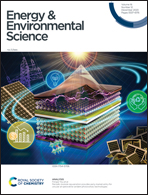Deconvoluting charge-transfer, mass transfer, and ohmic resistances in phosphonic acid–sulfonic acid ionomer binders used in electrochemical hydrogen pumps†
Abstract
Ion-pair high-temperature polymer electrolyte membranes (HT-PEMs) paired with phosphonic acid ionomer electrode binders have substantially improved the performance of HT-PEM electrochemical hydrogen pumps (EHPs) and fuel cells. Blending poly(pentafluorstyrene-co-tetrafluorostyrene phosphonic acid) (PTFSPA) with Nafion™, and using this blend as an electrode binder, improved proton conductivity in the electrode layer resulting in a 2 W cm−2 peak power density of fuel cells at 240 °C (a HT-PEM fuel cell record). However, much is unknown about how phosphonic acid ionomers blended with perfluorosulfonic acid materials affect electrode kinetics and gas transport in porous electrodes. In this work, we studied the proton conductivity, electrode kinetics, and gas transport resistances of 3 types of phosphonic acid ionomers, poly(vinyl phosphonic acid), poly(vinyl benzyl phosphonic acid), and PTFSPA by themselves and when blended with Aquivion® (a perfluorosulfonic acid material). These studies were performed using EHP platforms. For all phosphoric acid ionomer types, the addition of Aquivion® promoted ionic conductivity, hydrogen oxidation/evolution reaction kinetics (HOR/HER), and hydrogen gas permeability. Solid-state 31P NMR revealed that the addition of Aquivion® eliminated or significantly reduced phosphate ester formation in phosphoric acid ionomers and this plays a vital role in enhancing ionomer blend conductivity. Using the best blend variant, PTFSPA-Aquivion®, an EHP performance of 5.1 A cm−2 at 0.4 V at T = 200 °C was attained. Density functional theory (DFT) calculations identified that phosphonic acids with electron-withdrawing moieties reduced the propensity of the phosphonic acid to adsorb on platinum electrocatalyst surfaces. The relative adsorption affinity of the various phosphonic acid ionomers from DFT is consistent with experimentally determined charge transfer resistance. A voltage loss breakdown model revealed that the addition of Aquivion® reduced activation and concentration overpotentials in EHPs. Overall, a systematic experimental and modeling approach provided further insight as to how perfluorosulfonic acid ionomers blended with phosphoric acid ionomers affect ionic conductivity, reaction kinetics, and gas permeability in EHP platforms.



 Please wait while we load your content...
Please wait while we load your content...